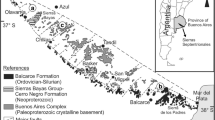Abstract
This paper investigates the potential of a laboratory test for the screening of aggregate reactivity to alkali–silica reaction (ASR) through phase analysis of the phases developed in ground aggregate paste (GAP) specimens subjected to accelerated ageing. GAPs were prepared using two aggregates categorised as non-reactive and potentially reactive by standard expansion test methods and were aged at 40, 60 and 80 °C in 1 M NaOH solution over periods up to 84 days. Phase development was monitored using TG, XRD and FTIR, and the reactivity was correlated with quartz and calcium hydroxide consumption. The data demonstrate that this test has the potential to be developed as a screening test, based on the correlation of phase consumption with Australian standard expansion test reactivity categorisation.






Similar content being viewed by others
References
Fournier B, Berube MA. Alkali–aggregate reaction in concrete: a review of basic concepts and engineering implications. Can J Civ Eng. 2000;27(2):167–91.
Rajabipour F, Giannini E, Dunant C, Ideker JH, Thomas MDA. Alkali–silica reaction: current understanding of the reaction mechanisms and the knowledge gaps. Cem Concr Res. 2015;76:130–46.
Ichikawa T. Alkali–silica reaction, pessimum effects and pozzolanic effect. Cem Concr Res. 2009;39(8):716–26.
Saha AS, Khan MNN, Sarker PK, Shaikh FA, Pramanik A. The ASR mechanism of reactive aggregates in concrete and its mitigation by fly ash: a critical review. Constr Build Mater. 2018;171:743–58.
Šachlová Š, Přikryl R, Pertold Z. Alkali–silica reaction products: comparison between samples from concrete structures and laboratory test specimens. Mater Charact. 2010;61(12):1379–93.
Hou X, Struble LJ, Kirkpatrick RJ. Formation of ASR gel and the roles of C–S–H and Portlandite. Cem Concr Res. 2004;34:1683–96.
Kawamura M, Iwahori K. ASR gel composition and expansive pressure in mortars under restraint. Cem Concr Compos. 2004;26:47–56.
Thomas MDA. The effect of supplementary cementing materials on alkali–silica reaction: a review. Cem Concr Res. 2011;41(12):1224–31.
HB79:2015, Alkali Aggregate reaction—Guidelines on minimising the risk of damage to concrete structures in Australia. 2015, Standards Australia.
Sirivivatnanon V, Mohammadi J, South W. Reliability of new Australian test methods in predicting alkali silica reaction of field concrete. Constr Build Mater. 2016;126:868–74.
AS1141.60.1:2014, Methods for sampling and testing aggregates, Method 60.1: Potential alkali–silica reactivity—Accelerated mortar bar method. 2014, Standards Australia.
AS1141.60.2:2014, Concrete prism test for assessment of alkali silica reaction in concrete aggregate. 2014, Standards Australia.
Thomas M, Fournier B, Folliard K, Ideker J, Shehata M. Test methods for evaluating preventive measures for controlling expansion due to alkali–silica reaction in concrete. Cem Concr Res. 2006;36:1842–56.
Fernandes I, Hooton D, Andiç-Çakır Ö. Assessing aggregates for alkali–aggregate reaction potential. Constr Mater. 2016;168:172–8.
Lindgård J, Rønning TF, Fournier B, Thomas MDA. Alkali–aggregate reaction: performance testing, exposure sites and regulations. Constr Mater. 2016;169:189–96.
Chatterji S. Chemistry of alkali–silica reaction and testing of aggregates. Cement Concr Compos. 2005;27:788–95.
Bérubé M-A, Fournier B. Canadian experience with testing for alkali–aggregate reactivity in concrete. Cement Concr Compos. 1993;15:27–47.
RILEM Recommended Test Method: AAR-4.1: detection of potential alkali–reactivity − 60°C test method for aggregate combinations using concrete prisms. In: Nixon PJ, Simms I, editors, RILEM recommendations for the prevention of damage by alkali–ggregate reactions in new concrete structures. State-of-the-Art Reports of the RILEM Technical Committee 219-ACS, vol. 17, pp. 99–116, 2016.
Kim T, Olek J. Effects of sample preparation and interpretation of thermogravimetric curves on calcium hydroxide in hydrated pastes and mortars. Transp Res Rec. 2012;2290:10–8.
Martín-Garrido M, Martínez-Ramírez S. CO2 adsorption on calcium silicate hydrate gel synthesized by double decomposition method. J Therm Anal Calc. 2020;9:9. https://doi.org/10.1007/s10973-020-09374-8.
Glasser LSD, Kataoka N. The chemistry of alkali aggregate reaction. Cem Concr Res. 1981;11:1–9.
Acknowledgements
The authors would like to acknowledge UTS CareerHub, the Australian Research Council Research Hub for Nanoscience Based Construction Materials Manufacturing (NANOCOMM) and Cement, Concrete and Aggregates Australia (CCAA) for their support.
Author information
Authors and Affiliations
Corresponding author
Additional information
Publisher's Note
Springer Nature remains neutral with regard to jurisdictional claims in published maps and institutional affiliations.
Rights and permissions
About this article
Cite this article
Boyd-Weetman, B., Thomas, P. Assessment of the ground aggregate paste (GAP) test for aggregate alkali–silica reactivity screening. J Therm Anal Calorim 142, 1635–1641 (2020). https://doi.org/10.1007/s10973-020-09768-8
Received:
Accepted:
Published:
Issue Date:
DOI: https://doi.org/10.1007/s10973-020-09768-8




